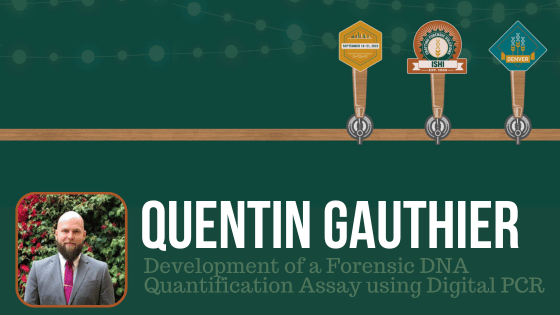Quantification of DNA in extracted samples offers key insights for an examiner’s decision on which downstream analysis to conduct. If the amount of nuclear DNA in a sample is too low for autosomal STR analysis, there may be the option to amplify the mitochondrial DNA present in the sample. Currently, however, these quantifications are achieved in two separate qPCR assays which increases the cost, time for analysis, and sample consumption. Additionally, the use of qPCR introduces the risk of imprecise measurements due to the relative quantification of samples compared to the standards, which themselves may also introduce some level of imprecision. A newer technology, digital PCR, eliminates the need for standards by separating a PCR reaction into thousands of nanoliter reactions to provide direct, absolute quantification.
The concept of dPCR is to take a standard volume PCR quantification reaction and to divide it into thousands of partitions to create independent PCR reactions. These nanoliter-sized reactions still contain all the components necessary for PCR, but commonly with only one copy of the target DNA in the partition. With a known number of total partitions and the ability to count individual partitions fluorescing at a specific wavelength, the number of copies of target DNA in the original sample can be determined directly using Poisson statistics, but without the need for standards. This technology also boasts a lower limit of quantification. The latest versions of these instruments can query at least five different dye channels, providing an opportunity to simultaneously probe the concentration of nuclear, mitochondrial, and male DNA, as well as a target for degradation and an internal positive control for inhibition.
In his presentation at ISHI 34 this year, Quentin will share the initial development for this combined nuclear and mitochondrial DNA quantification assay. Efforts thus far have focused on translating the Federal Bureau of Investigation’s mitochondrial qPCR assay to the QIAGEN QIAcuity dPCR instrument. The work conducted has been: 1) to verify that qPCR and dPCR produce comparable results for the individual components of the mitochondrial quantification assay, 2) optimization of primer and probe concentrations for reproducibility, 3) identification of optimal fluorophores for improved signal strength, 4) testing common inhibitors (Humic Acid, Tannic Acid, Hematin, EDTA, Collagen, Melanin and Guanidine Thiocyanate) to determine if the mitochondrial quantification assay is more resilient to inhibition using dPCR, and 5) testing assay sensitivity to as few as 0.5 copies per microliter.
What is one key learning that attendees will be able to take back to the lab and implement based on your presentation?
That we are starting a new chapter when it comes to quantitative PCR and many laboratories can start thinking about how digital PCR could change their approach to sample quantitation and how eliminating calibration curves could increase the number of samples they can run in a single go.
Do you think anything in your presentation will surprise the audience? If so, can you give us a teaser?
It is surprisingly easily to translate quantitate PCR assays from real-time instruments to digital instruments, opening up a lot of possibilities.
Who in the audience will benefit most from your presentation? If someone was interested in learning more about your topic, do you have recommendations for resources?
People looking for innovation and improvements to the workflow in forensic laboratories will benefit the most from this presentation. A fantastic resource for understanding digital PCR and how it relates to nuclear and mitochondrial quantitation is NIST’s Erica Romsos.
What inspired you to seek out a career in the forensic field?
I’ve always been interested in the sciences and how to apply it to solving puzzles, so forensic felt like a natural fit.
If you could go back in time, what advice would you give to your younger self as you were starting out?
Ignore the crime scene forensics. The laboratory is where the fun stuff is.
If you had to pick one thing, what do you enjoy most about your job?
Getting to throw out the SOP and do whatever it takes to achieve a better result.
If you currently work in the lab, or have in the past, what’s the weirdest thing you’ve ever collected DNA from?
Snapper DNA brought straight from the Florida Keys.
If you’ve attended ISHI in the past, what do you most enjoy about coming to the conference?
I really enjoy getting to connect with new people from all over the country and hearing what problems they’re facing in the laboratory. I also really like getting to reconnect with friends from grad school. For first timers, don’t be afraid to talk to anyone and everyone. You never know what you might learn.
What is one item on your bucket list? Have you checked if off yet?
I really want to go skydiving. Hopefully someday.
What’s one thing that others may not know about you?
Despite my best efforts, I ended up with a degree in chemistry, my least favorite subject in high school.
WOULD YOU LIKE TO SEE MORE ARTICLES LIKE THIS? SUBSCRIBE TO THE ISHI BLOG BELOW!
SUBSCRIBE NOW!


